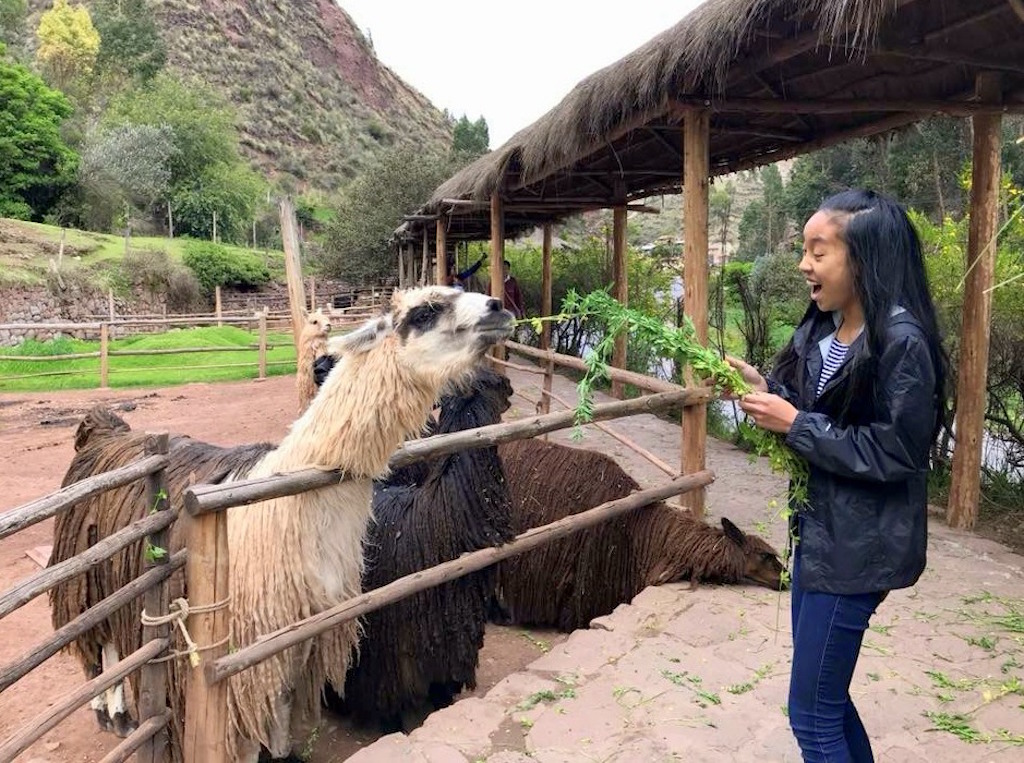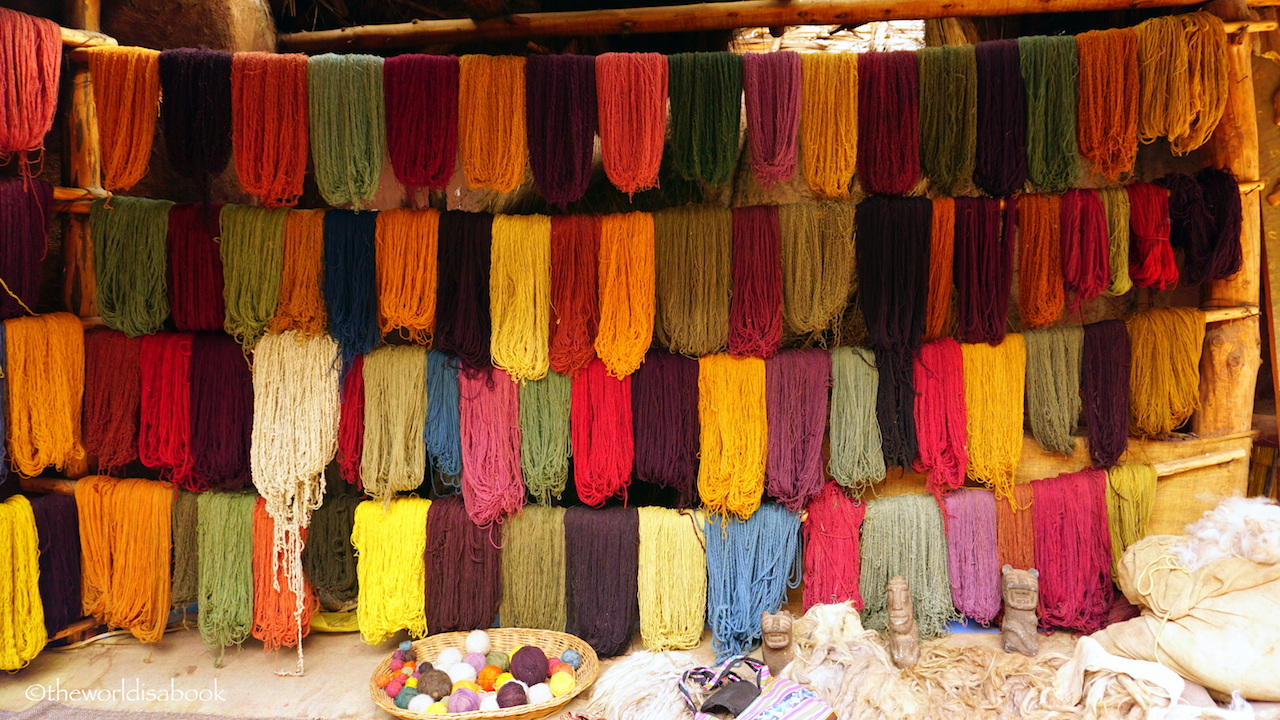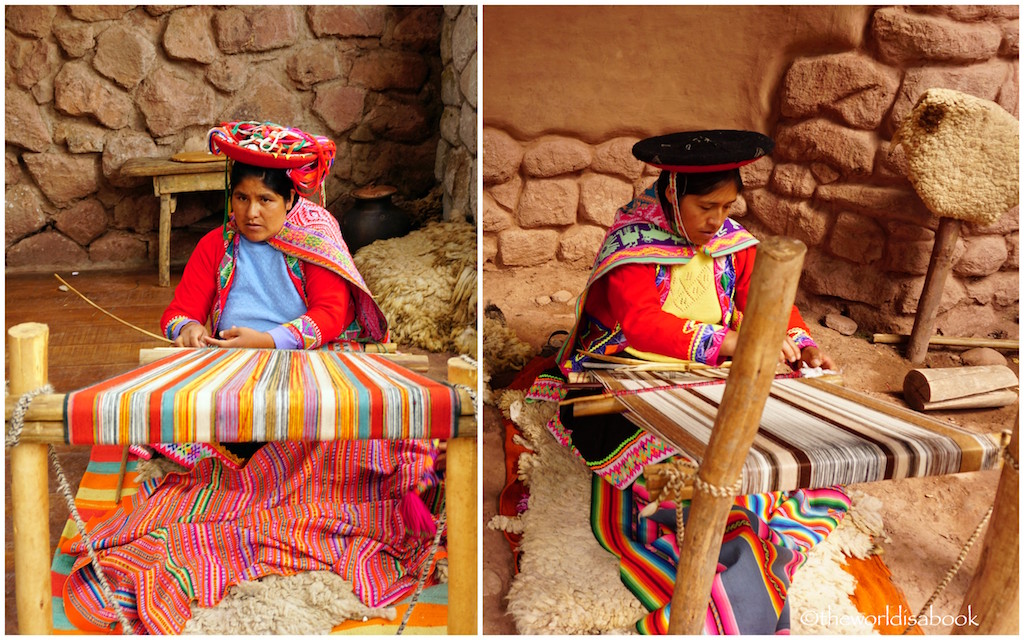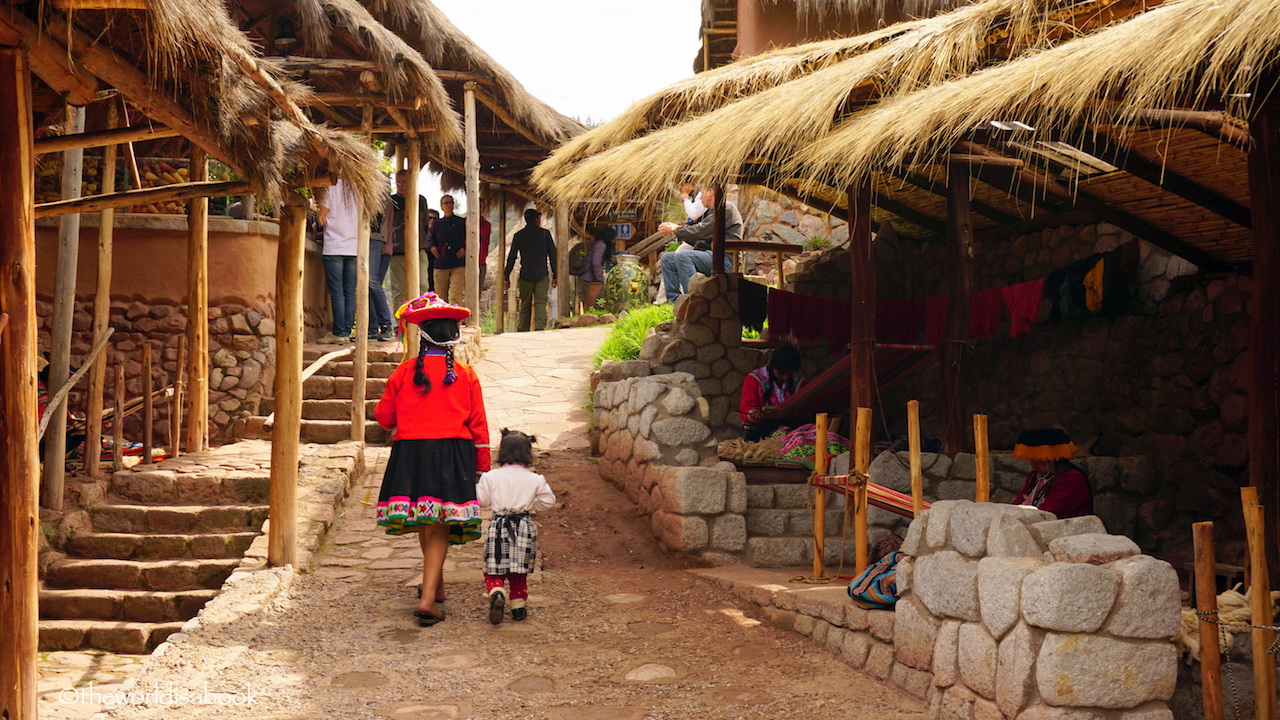Our first stop on our way to the Sacred Valley of Peru from Cusco was the Awana Kancha weaving center. Located about 15.5 miles (25 km) from the main city of Cusco, it was an easy side trip and a popular stop for many of the tours going to the Sacred Valley. Enclosed behind adobe walls, Awana Kancha wasn’t a very big place. But, it was filled with many interesting and informative attractions.

The Animals
Its name may sound a bit deceptive as a weaving center. But, the main reason we stopped here was to see the resident animals of the center. It had four members of the camelid family here common in South America in several enclosures. They had llamas, alpacas, vicunas and guanacos. Of course, we’ve heard of the first two but never heard of the vicunas and guanacos.
We found out some differences among the four animals. The vicunas and guanacos were the wild part of the family who live in the high Andes. While the alpacas and llamas were the domesticated ones. Llamas have longer ears compared to the alpaca’s spear-shaped ears. Alpacas also have more hair on their face than the alpacas.
Guanacos have large heads with pointed ears and long necks along with long legs. They have wooly coats ranging from light brown to rusty red. The vicunas were on the hillside and the smallest of the camelids. The lone one behind the alpacas was as close as we got to seeing them.
The center provided plenty of free grassy stalks for visitors to feed the animals. There were several open enclosures along the pathway so we could pick which animals to approach. They told us the animals were grouped by species and sex.
The kids squealed with excitement upon seeing some adorable alpacas. We continuously heard a lot of “ohhs” and “ahhs” mixed with a lot of laughter here among all the visitors. Who could blame us? These animals were friendly and adorable.
The animals were so used to people handing them food that they readily came up to us again and again. We got some saliva in return from some animals. But, it was all worth it. It was a good thing those stalks were long.
One of my teen daughter’s Peru wish list was to pet an alpaca. She definitely fulfilled that wish and so much more than she could ever hope for interacting and feeding these animals. It was hard to stop taking photos of the animals.
Dealing with Altitude Sickness
On a side note, altitude sickness affected us as soon as we walked up a small hill to the center’s entrance. We had just gotten off the plane in Cusco a few hours earlier. We made the decision to descend into the Sacred Valley which was considerably lower than Cusco’s 11,152 feet (3,399 m) above sea level of elevation. We thought that would help a bit and it did…in the long run.
But, we all instantly felt lightheaded with rapid heartbeat as soon as we climbed the hill. It was harder to breathe and some of us felt nauseous too. It was a very weird feeling. We all had to take some rest for a few minutes before entering the animal enclosures and drank a lot of water. Chewing some coca candy we got at the Lima airport also helped.
So, a major tip is don’t do anything strenuous after getting off the plane in Cusco. Make it a rest day and take it easy. We also made a mistake of going up the Pisac ruins after this which didn’t help very much.
The Weavers
Another great thing we loved about the Awana Kancha Center was learning and seeing the progression on how the animals’ wool was harvested, refined, naturally dyed and were turned into unique Peruvian textiles and woven pieces.
The center had exhibits and an interpretive area for visitors. They showed how the alpaca and llama wool were dyed using natural items like leaves, seeds, fruits and even cacti.
It was amazing to see the different colors they could come up with using things found around their area. These were all the colored wool hanging and ready to be woven.
There were also several native women dressed in their colorful attire demonstrating how they turned animal fibers/hair into exquisite products using the dyed wool. They were using ancient looms and traditional weaving techniques to make a variety of items. They all made it look effortless.
We were told that it could take weeks to months depending on how big or intricately detailed the items were. It was almost mesmerizing to watch them and especially see their hands work through the threads. It also couldn’t have been easy to constantly be interrupted with all the visitors gawking at them.
Viewing the Textiles
To fully appreciate the finished products these women meticulously worked on, everyone shouldn’t miss the large gift shop. It will be hard to walk out of here empty handed. They had so many exquisite items for sale and most were handmade.
I wish I had the budget to buy the unique handmade scarves and blankets. There were tapestries, table runners and rugs worth thousands of dollars due to the amount of work it took to create them.
This was one of the best places in Cusco and the Sacred Valley to get some authentic and beautiful items. Unfortunately, we couldn’t take pictures while in the shop. But, it was easy to see and feel the difference between the handmade items made of alpaca wool versus the machine produced items.
The Awana Kancha Center was a fantastic stop for the entire family and visitors on the way to/from the Sacred Valley. We were a bit worried this was going to be a tourist trap at first. But, it was a lot of fun for adults and children feeding and interacting with the animals at the farm.
While it was great to see the animals, it was also a wonderful educational experience look at their wool and see it transform to an extraordinary finished product. It made us appreciate all the handmade Peruvian textiles we saw all around the Sacred Valley even more knowing the effort it took to make them.
Tips for Visiting the Awana Kancha Center
- There were no entry fees. But, please make it a point to buy something at the gift shop or leave a donation. For souvenir collectors, they also had affordable magnets and a variety of Christmas ornaments. The gift shop accepts credit cards.
- There was a small snack shop here too. Buy some snacks or a refreshing drink to help the center.
- There were no tour guides on the site. But, there were several tours that stop here and it wasn’t hard to listen in or overhear some of the tour guides discuss the wool dyeing process or more about the animals.
- This was also a good place for a restroom stop.
- If you’re looking into doing a Sacred Valley tour from Cusco, please be sure this stop is included.
- We spent over an hour here which was enough to see the animals, the weavers and look around the gift shop.
*Have you visited Peru? Where are your favorite animal encounters?
Pin it for later!











This is so beautiful! I love that your daughter lived out her dream there with the alpacas. It was interesting to read about the altitude sickness too. The yarn is beautiful – magnificent to see how it’s all woven together by the local women.
Love those colorful textiles – and well, who doesn’t love cute, furry animals like alpacas? Sorry to hear about the altitude sickness but glad you worked your way into it. My sister-in-law went to Peru several years ago and she ended up so sick which pretty much ruined the trip for her. Good tip to know to ease into it.
I’m hoping to visit an alpaca and llama farm too when we go to Peru. I love these cute animals and could never get close to one before. As for altitude sickness, I experience it before when we traveled to Jungfraujock (“the top of Europe”) in Switzerland. It’s not a pleasant feeling.
so am i
what lovely villages with llamas! The weaving work is just beautiful and I’d love to see it done in person! Great tip on having a rest day when you vist arrive to help get accustomed to the altitude! Thanks for much for sharing on #TheWeeklyPostcard!
thank you for nothing
We visited this centre a couple of years ago on our trip to Cusco and the Sacred Valley. The store did have some absolutely beautiful textiles and clothing. Thankfully, we also found some wonderful stores in Cusco where we ended up after 5 days in the Sacred Valley and Machu Picchu. By then, we were fully able to appreciate how spectacular some of the work was and make some informed purchases. My kids also loved feeding the llamas and alpacas.
This looks like such a wonderful experience. I would love to do some traveling and this makes me want to put Peru on the list of places to visit.
They’re so FLUFFY! This is the kind of thing I’d love to do and its a region I’d love to visit but I have been worried about the altitude sickness. One day! #TheWeeklyPostcard
What an amazing experience and a great way to spend some hours away from Cusco. Now I have this place on my bucket list for the next time we’ll visit Peru, hopefully soon!I am sure my kids will love to see so many llama and alpacas in one place, especilly if they’re so used with people around.
P.s.- I love the pictures you took, they’re so full of life and colorful.